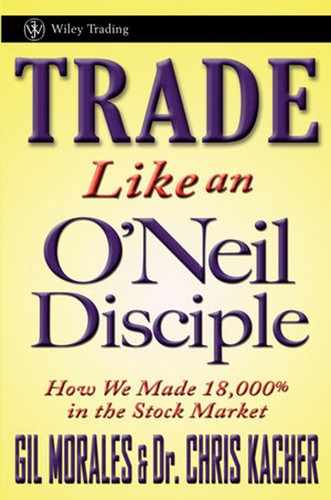2.3. 1997—KEEPING PROFITS DURING THE ASIAN CONTAGION
During the first quarter of 1997, the market was in a downtrend. By April, some portfolio managers with whom I was speaking were ready to throw in the towel for the year as frustration ran high. I had stayed mostly in cash during this period as my timing model had been on a sell signal, and there were almost no stocks worth buying. Then on April 22, my timing model gave a buy signal, shown in Figure 2.5—the first buy signal since early January—and I noticed fundamentally strong stocks in sound bases starting to break out.
Figure 2.5. NASDAQ Composite Index daily chart, 1997.: Chart courtesy of eSignal, Copyright 2010

Figure 2.6. NASDAQ Composite Index daily chart 1997. The Asian Contagion.: Chart courtesy of eSignal, Copyright 2010

I bought the strongest of stocks, then as the rally continued, I would sell the weakest names to make room for any new strong names breaking out. I was effectively force feeding any available buying power into the strongest names. The market continued on its uptrend into October. I then was surprised to see that just over a few days, by October 17, most all of my stocks suddenly hit their sell alerts, just a few days before the market imploded. The massive sell-off was caused by the Asian currency crisis, shown in Figure 2.6. I had no idea this crisis was going to occur when it did nor that the market would sell off so hard. But as I had always done before, I sold when my stocks hit their sell alerts. Thus, I was safely in cash a few days before the markets got slammed. My drawdown off the peak was just −6.5 percent compared to the −16.2 percent drawdown in the NASDAQ.
Incidentally, my success-to-failure rate in 1997 was one of the lowest ever, with the number of my losing trades outnumbering my winning trades by roughly 4:1, or a success rate of just over 20 percent. Yet I was able to achieve a triple digit return, just barely (102 percent according to my accounting, 98 percent according to KPMG) because the home runs made all the difference. I point this out to illustrate that the number of profitable trades is perhaps the least important variable with this investment methodology. The percent gained on a trade is a far more important variable. That said, in other bull market years, my success rate is usually closer to 50 percent.
